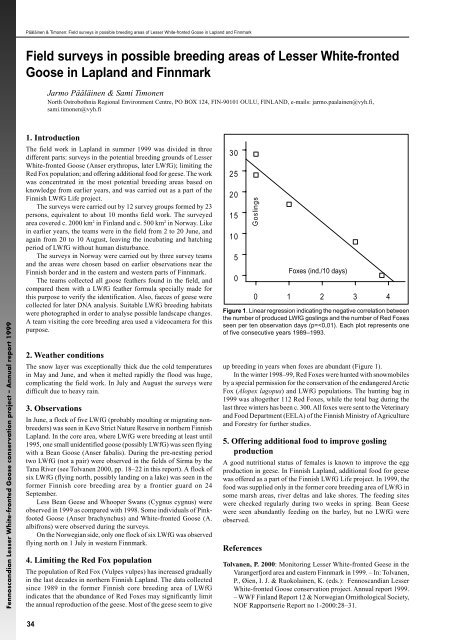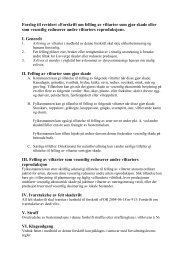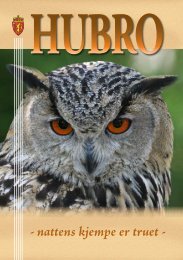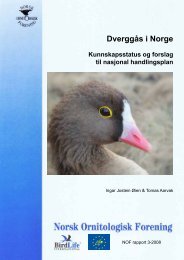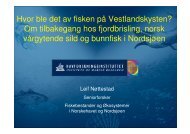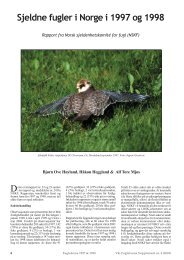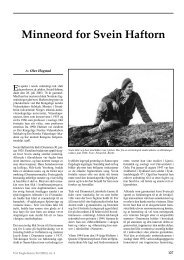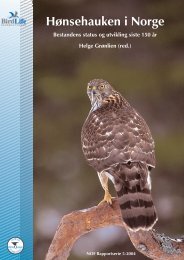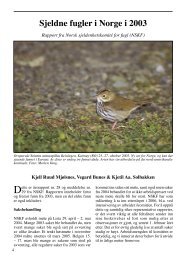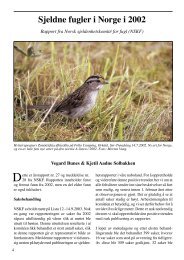Fennoscandian Lesser White-fronted Goose conservation project ...
Fennoscandian Lesser White-fronted Goose conservation project ...
Fennoscandian Lesser White-fronted Goose conservation project ...
You also want an ePaper? Increase the reach of your titles
YUMPU automatically turns print PDFs into web optimized ePapers that Google loves.
<strong>Fennoscandian</strong> <strong>Lesser</strong> <strong>White</strong>-<strong>fronted</strong> <strong>Goose</strong> <strong>conservation</strong> <strong>project</strong> – Annual report 1999<br />
Pääläinen & Timonen: Field surveys in possible breeding areas of <strong>Lesser</strong> <strong>White</strong>-<strong>fronted</strong> <strong>Goose</strong> in Lapland and Finnmark<br />
Field surveys in possible breeding areas of <strong>Lesser</strong> <strong>White</strong>-<strong>fronted</strong><br />
<strong>Goose</strong> in Lapland and Finnmark<br />
34<br />
Jarmo Pääläinen & Sami Timonen<br />
North Ostrobothnia Regional Environment Centre, PO BOX 124, FIN-90101 OULU, FINLAND, e-mails: jarmo.paalainen@vyh.fi,<br />
sami.timonen@vyh.fi<br />
1. Introduction<br />
The field work in Lapland in summer 1999 was divided in three<br />
different parts: surveys in the potential breeding grounds of <strong>Lesser</strong><br />
<strong>White</strong>-<strong>fronted</strong> <strong>Goose</strong> (Anser erythropus, later LWfG); limiting the<br />
Red Fox population; and offering additional food for geese. The work<br />
was concentrated in the most potential breeding areas based on<br />
knowledge from earlier years, and was carried out as a part of the<br />
Finnish LWfG Life <strong>project</strong>.<br />
The surveys were carried out by 12 survey groups formed by 23<br />
persons, equivalent to about 10 months field work. The surveyed<br />
area covered c. 2000 km2 in Finland and c. 500 km2 in Norway. Like<br />
in earlier years, the teams were in the field from 2 to 20 June, and<br />
again from 20 to 10 August, leaving the incubating and hatching<br />
period of LWfG without human disturbance.<br />
The surveys in Norway were carried out by three survey teams<br />
and the areas were chosen based on earlier observations near the<br />
Finnish border and in the eastern and western parts of Finnmark.<br />
The teams collected all goose feathers found in the field, and<br />
compared them with a LWfG feather formula specially made for<br />
this purpose to verify the identification. Also, faeces of geese were<br />
collected for later DNA analysis. Suitable LWfG breeding habitats<br />
were photographed in order to analyse possible landscape changes.<br />
A team visiting the core breeding area used a videocamera for this<br />
purpose.<br />
2. Weather conditions<br />
The snow layer was exceptionally thick due the cold temperatures<br />
in May and June, and when it melted rapidly the flood was huge,<br />
complicating the field work. In July and August the surveys were<br />
difficult due to heavy rain.<br />
3. Observations<br />
In June, a flock of five LWfG (probably moulting or migrating nonbreeders)<br />
was seen in Kevo Strict Nature Reserve in northern Finnish<br />
Lapland. In the core area, where LWfG were breeding at least until<br />
1995, one small unidentified goose (possibly LWfG) was seen flying<br />
with a Bean <strong>Goose</strong> (Anser fabalis). During the pre-nesting period<br />
two LWfG (not a pair) were observed in the fields of Sirma by the<br />
Tana River (see Tolvanen 2000, pp. 18–22 in this report). A flock of<br />
six LWfG (flying north, possibly landing on a lake) was seen in the<br />
former Finnish core breeding area by a frontier guard on 24<br />
September.<br />
Less Bean Geese and Whooper Swans (Cygnus cygnus) were<br />
observed in 1999 as compared with 1998. Some individuals of Pinkfooted<br />
<strong>Goose</strong> (Anser brachynchus) and <strong>White</strong>-<strong>fronted</strong> <strong>Goose</strong> (A.<br />
albifrons) were observed during the surveys.<br />
On the Norwegian side, only one flock of six LWfG was observed<br />
flying north on 1 July in western Finnmark.<br />
4. Limiting the Red Fox population<br />
The population of Red Fox (Vulpes vulpes) has increased gradually<br />
in the last decades in northern Finnish Lapland. The data collected<br />
since 1989 in the former Finnish core breeding area of LWfG<br />
indicates that the abundance of Red Foxes may significantly limit<br />
the annual reproduction of the geese. Most of the geese seem to give<br />
30<br />
25<br />
20<br />
15<br />
10<br />
5<br />
0<br />
Goslings<br />
r2=0.96<br />
Foxes (ind./10 days)<br />
0 1 2 3 4<br />
Figure 1. Linear regression indicating the negative correlation between<br />
the number of produced LWfG goslings and the number of Red Foxes<br />
seen per ten observation days (p=


